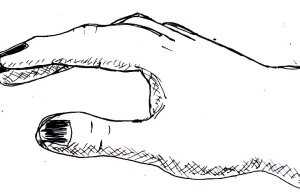Although I’ll sometimes scan the lineart of one of my paintings before I start painting, traditional lineart is one of those art forms that I’ve probably overlooked slightly.
At most, I only really tend to use lineart for quick sketches like this “realistic” sketch of my right hand I made when I was practicing drawing hands a few weeks ago:
And, as I mentioned earlier, I’ll also sometimes use lineart for bonus features and/or previews on this site too. Like this preview of Sunday’s painting:
But, thinking about it, lineart is probably one of the best art forms out there. Yes, it might lack the vividness or versatility of painting but it’s both one of the simplest and the most challenging types of art to create.
In most types of lineart, you literally just have two colours to work with – black and white.
Whilst this means that you don’t have to spend a lot of time mixing paints or deciding on a colour scheme for your picture, it also means that you have to pay a lot more attention to the contrasts between light and darkness in your picture in order to ensure that the right parts of your picture stand out and the whole thing doesn’t look like a confusing scribbled mess.
But, although you’ve only got two colours to work with, you can of course create the illusion of grey areas in your pictures using techniques like cross-hatching (like the shadows in the picture of my hand I showed you earlier), using diagonal lines and using lots of little random dots.
Not only that, you can also vary the line width in order to emphasise things too. So, it’s actually a more versatile art form than many people think it is.
In addition to this, a good piece of lineart can’t really have too much detail in it either – otherwise it just becomes a confusing mess. What this means is that lineart has to focus on the most important parts of whatever or whoever you are drawing, it has to be a “distilled” version of whatever you’re drawing.
Whilst some people might think that this is a limitation, I’d argue that being able to “distil” things down to their most important elements is one of the most useful skills that an artist can have.
Being able to “distil” a picture down into it’s most important parts is not only useful for making good art quickly, but it’s also an essential skill to have if you’re sketching from life and/or from photographs too, since you probably won’t have time to copy every tiny detail of the scene that you’re looking at.
Not only that, a good piece of lineart almost always looks “professional” in a way that a pencil drawing and/or a coloured pencil drawing might not always do. Plus , the only art supplies you need to make lineart are a pen and a piece of paper – it’s the ultimate form of low-budget creativity.
Plus, of course, lineart can be the basis for all sorts of other types of art too. In other words, once you’ve got your lineart – you can always add to it later if you want to turn it into a colour picture.
If you’ve drawn on “ordinary” paper or cardboard, you can add coloured pencil or pastel to your lineart if you want to. Or, if you’ve drawn it on watercolour paper, then you can also add watercolour too. It’s up to you.
So, yes, lineart is wonderful 🙂
——-
Sorry for yet another short and basic article, but I hope that it was interesting 🙂



This is a nice summary on why I love drawing with ink so much. One can condense the essential parts of the piece into just the lines which – as you wrote – is especially challanging because you only have black and white to work with. Also I think it offers you the opportunity to create moods you could never achieve with color. 🙂
Thanks 🙂 Totally, although I didn’t realise that you could create moods in B&W art that you can’t create in colour art though. Then again, most of my art tends to be in colour, so I haven’t really experimented with B&W drawing as much as I probably should.
I’d recommend you to try it out.. Especially if you use black shapes and shadows, you can add to the overall effect of your drawing. 🙂
Thanks 🙂 I’ve already got about two months’ worth of colour paintings queued up for this site, but it’s certainly something that I’ll try in the future … even if it takes a while for it to appear on here.
[Edit: I’ll post some B&W lineart on here on the 8th and 9th of December. There will also be a couple of greyscale/sepia pictures posted here near the end of November too. Thanks again for the suggestion 🙂 ]
I’m curious to see it. 🙂 Keep the work up!
Here’s a sneak peek at one of my B&W drawings that will be posted here in December (based on a photo of a street in Berlin that I took when I visited there in 2004). Enjoy 🙂
“Berlin Noir” By C. A. Brown
[…] If you want a closer look at the drawing in the top right corner of this preview, then it can be found hiding in the comments below this article. […]
[…] this isn’t an article about why B&W ink drawings are awesome (I’ve already written one of those – ironically, I wrote it a couple of months before I really seriously got into using this […]